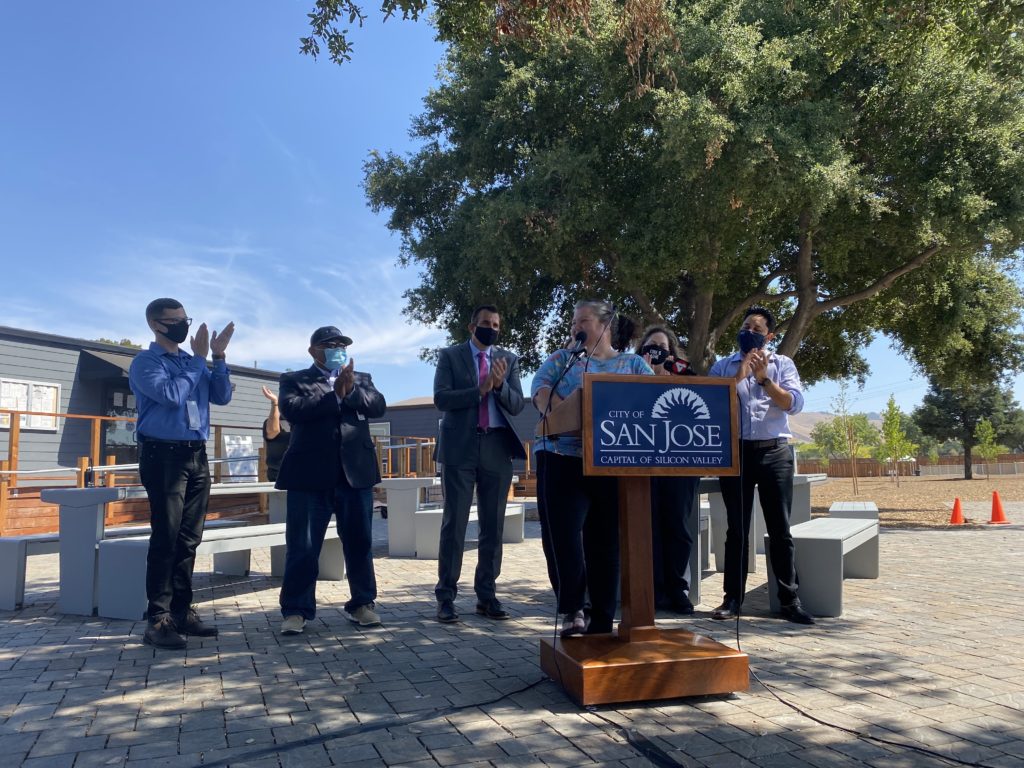San Jose aims to cut its homeless population by 20% by the end of next year through a new initiative to provide more housing and job stability.
Mayor Sam Liccardo, joined by Councilmembers Sergio Jimenez, Dev Davis and Pam Foley, announced a plan called “Compassionate and Clean San Jose” Wednesday that would triple the number of emergency housing units in the city, bringing the number of available units to 1,000 by December 2022.
The initiative was also backed by Councilmembers David Cohen, Raul Peralez and Matt Mahan.
City officials hope to start construction on one emergency housing site in two months. The City Council is expected to consider its approval in October.
The city hopes to achieve its ambitious goal through prefabricated modular units—a model similar to the bridge housing site on Rue Ferrari in South San Jose. The city will also rely on 300 converted motel units funded through the state’s Project Homekey.
“We are committed to a goal of rehousing at least 1,500 of our unhoused residents and getting 2,300 new permanent and transitional units into the pipeline,” Liccardo said.
The number of unhoused residents in San Jose has exploded over the last few years. In 2019, the number exceeded more than 6,100 people. No one knows for sure how many more people have been pushed onto the streets in the last two years because Santa Clara County canceled its biennial homeless count in January citing COVID-19 concerns.
The plan also calls for adding 200 more positions to the San Jose Bridge program, an initiative led by Liccardo that employs homeless residents to pick up trash. The program just saw an expansion last week.
“Part of the effort around combining housing with (the San Jose Bridge program) is we need to make sure that workers are actually getting the housing first if they’re out there cleaning our city,” Liccardo said. “That’s key for us in building out more of these communities.”
During the COVID-19 pandemic, San Jose added more than 300 interim housing units to three different sites across the city. These types of homes took months, not years, to build and can immediately get people off the street, the mayor said. The cost per such unit is also at a much lower rate: $100,000 to $110,000 per unit. Permanent housing costs hover at approximately $750,000 per unit.
Emergency housing projects have proven successful for some locals.

Jaki Vantrease and her husband David Houpt became unhoused in 2007, and have been living at the emergency housing site on Rue Ferrari since February.
The pandemic has made it challenging for them to move out of the interim housing, Houpt said. But on Wednesday, to the clapping and cheering of city officials, Vantrease announced the couple finally signed a lease to an apartment. Twenty one participants with San Jose Bridge have also found permanent jobs, officials said.
“It’s been too long since we are out living on streets,” Vantrease told San José Spotlight, adding that she’s excited to cook again.
The city is in the process of developing two interim housing sites, in Districts 3 and 10 respectively. It’s not immediately clear how many units these sites will provide.
Councilmember Matt Mahan, who was not at the event, is pushing efforts to find public land for prefabricated homes. His proposal, which calls for a list of at least six sites by December, is up for discussion at the city’s Rules Committee meeting on Wednesday.
Mahan believes his plan, upon the City Council’s approval and collaboration with the county, could help house up to 5,000 people.
“With about 50 acres countywide, we could quite easily build enough shelter for every unhoused person in our county,” Mahan told San José Spotlight.
San Jose and Santa Clara County have “a unique opportunity to significantly reduce if not end street homelessness in our community,” because of state funding, Mahan added.
“I hope (the mayor) does get the assistance that he needs,” Houpt said. “This is an awesome program. It just needs to take off.”
Contact Tran Nguyen at [email protected] or follow @nguyenntrann on Twitter.



Leave a Reply
You must be logged in to post a comment.